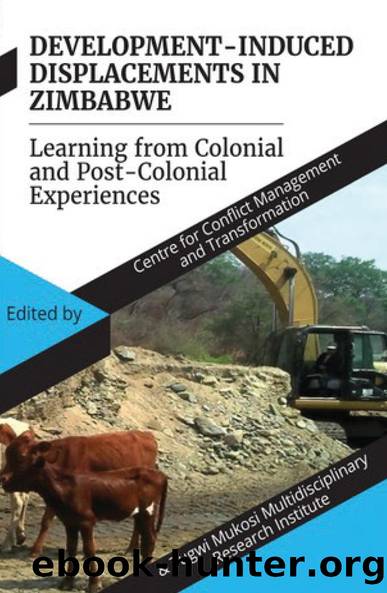Development Induced Displacements in Zimbabwe by CCMT CCMT

Author:CCMT CCMT [CCMT, CCMT]
Language: eng
Format: epub
ISBN: 9781779223869
Barnesnoble:
Publisher: African Books Collective Limited
Published: 2021-03-01T00:00:00+00:00
The Governorâs complaisant responses to the Authorityâs queries assuaged the Tongaâs anxieties about the forced departures from their homelands. The government agreed to allow hundreds of Tonga families to move back to the edge of the reservoir to reoccupy unflooded land (Scudder 2009, p.38) and to provide piped water to the few Tonga families that settled near the new lake. Habanyana later acknowledged at a commission of enquiry about the relocations that the GNA agreed to relocate and make way for the dam because they were satisfied with the Northern Rhodesian governmentâs assurances of compensation and other benefits to accrue from the lake. âOur minds were clear thenâ, he conceded, and âwe knew that the government was taking the move very seriously and that every aspect of the problem was being considered in the interest of our peopleâ2 (Habanyana quoted in Howarth 1961, p.52).
In spite of these concessions and promises, some of the Zambian Tonga found it difficult to accept leaving their homes and fields. They could not give up their ancestral lands without fighting. In September 1958 some men attempted armed resistance at Chipepo in Chief Chisamuâs area. Upon hearing about the Chipepo peopleâs reluctance to relocate, Governor Benson visited the area to encourage the resistors to move and after some futile negotiations he then warned the Chipepo men that âThe Queenâs words must be obeyed. If they are not obeyed, it will be necessary to enforce themâ (Clements 1959, p.147). The following altercations on 10 September resulted in colonial policemen and soldiers shooting to death eight people and wounding 34 others.3 Elizabeth Colson observed that from this point the Tonga were a âshocked and frightened peopleâ, fully aware of their fate if they defied government (Colson 1971, p.15). These massacres at Chipepo reveal that even the moderately inclined Northern Rhodesian authorities that seemed pliant to African demands and concerns at the time of displacement had limits to which they could tolerate African defiance. Despite this violent setback, the relocation process unfolded without further destabilisation and the Northern Rhodesian government honoured some of their promises to compensate and safeguard the Tongaâs welfare after displacement.
4. Compensation for the Zambian Tonga and access to the new Kariba reservoir
In early 1960, the Northern Rhodesian government negotiated with the Federal Power Board for a settlement of £1,374,000. Much of this amount was paid out in five instalments to the Gwembe Special Fund for local infrastructural development, such as irrigation schemes, veterinary services, water supply, and especially the development of the fishery on Lake Karibaâs northern shoreline. On 14 October 1960 the Federal Minister of Power, Sir Malcolm Barrow presented £200,000 to the Gwembe Native Authority, by now known as the Gwembe Rural Council, for direct compensation for resettlement losses and any âhardships encountered in movingâ (Soils Incorporated Private Limited 2000, p.32). The colonial administrators agreed to a simple formula of compensation for property lost during relocation, particularly huts and riverine fields. They paid £134 to every person displaced and £10 for every house deserted because of relocation or lost due to inundation.
Download
This site does not store any files on its server. We only index and link to content provided by other sites. Please contact the content providers to delete copyright contents if any and email us, we'll remove relevant links or contents immediately.
Nudge - Improving Decisions about Health, Wealth, and Happiness by Thaler Sunstein(6644)
iGen by Jean M. Twenge(4708)
The Fire Next Time by James Baldwin(4352)
Adulting by Kelly Williams Brown(3682)
The Sports Rules Book by Human Kinetics(3597)
The Hacking of the American Mind by Robert H. Lustig(3589)
The Ethical Slut by Janet W. Hardy(3513)
Captivate by Vanessa Van Edwards(3310)
Mummy Knew by Lisa James(3176)
In a Sunburned Country by Bill Bryson(2954)
The Worm at the Core by Sheldon Solomon(2929)
Ants Among Elephants by Sujatha Gidla(2929)
Suicide: A Study in Sociology by Emile Durkheim(2617)
The Slow Fix: Solve Problems, Work Smarter, and Live Better In a World Addicted to Speed by Carl Honore(2579)
Humans of New York by Brandon Stanton(2383)
Handbook of Forensic Sociology and Psychology by Stephen J. Morewitz & Mark L. Goldstein(2380)
Blackwell Companion to Sociology, The by Judith R. Blau(2320)
The Happy Hooker by Xaviera Hollander(2277)
Outliers by Malcolm Gladwell(2263)
